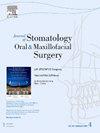耳部截肢再植技术的比较。
IF 1.8
3区 医学
Q2 DENTISTRY, ORAL SURGERY & MEDICINE
Journal of Stomatology Oral and Maxillofacial Surgery
Pub Date : 2024-10-01
DOI:10.1016/j.jormas.2023.101497
引用次数: 0
摘要
背景:对于外科医生来说,外伤性耳朵截肢的处理仍然是一种罕见且困难的情况。这是因为所选择的再植技术必须确保最佳的血管供应,并且必须保留周围组织,以免在再植失败的情况下危及未来的耳廓重建。目的:本研究旨在回顾和综合迄今为止描述的不同手术技术在外伤性耳朵截肢(部分或全部)治疗中的文献。材料和方法:根据PRISMA声明指南,在PubMed、ScienceDirect和Cochrane Library数据库中检索相关文章。结果:共保留了67篇文章。在可能的情况下,显微外科再植可以获得最佳的美容效果,但需要重要的护理。结论:不应采用口袋技术和局部皮瓣,因为其美容效果较低,且使用了周围组织。然而,它们可以保留给没有先进重建技术的患者。在可能的情况下,在患者同意输血、术后护理和住院后,可以尝试显微外科再植。建议对耳垂截肢和三分之一以下的耳朵截肢进行简单的复位。当无法尝试显微外科再植时,如果切除的节段是可行的并且大于三分之一,则可以尝试简单的再接,这会增加再植失败的风险。如果失败,可以考虑由经验丰富的耳廓外科医生或假体进行耳廓重建。本文章由计算机程序翻译,如有差异,请以英文原文为准。
A comparison of ear amputations replantation techniques
Background
The management of traumatic ear amputations remains a rare and difficult occurrence for surgeons. This is due to the fact that the chosen replantation technique must ensure the best vascular supply and the surrounding tissues have to be preserved as to not jeopardize a future auricular reconstruction in the event of replantation failure.
Objective
This study aimed to review and synthesize the literature about the different surgical techniques described to date in the management of traumatic ear amputations (partial or total).
Materials and methods
Relevant articles were searched on PubMed, ScienceDirect, and Cochrane Library databases in accordance with the PRISMA statement guidelines.
Results
A total of 67 articles was retained. When possible, microsurgical replantation enabled the best cosmetic result but required important care.
Conclusion
Pocket techniques and local flaps should not be performed because of the lower cosmetic result and the use of the surrounding tissues. However, they could be reserved for patients without access to advanced reconstructive techniques. When possible, microsurgical replantation can be attempted after patient consent for blood transfusions, postoperative care and hospital stay. Simple reattachment for earlobe amputations and ear amputations up to one third is recommended. When microsurgical replantation cannot be attempted, and if the amputated segment is viable and bigger than one third, simple reattachment may be attempted with an increased risk of replantation failure. In case of failure, an auricular reconstruction by an experienced microtia surgeon or prosthesis may be considered.
求助全文
通过发布文献求助,成功后即可免费获取论文全文。
去求助
来源期刊

Journal of Stomatology Oral and Maxillofacial Surgery
Surgery, Dentistry, Oral Surgery and Medicine, Otorhinolaryngology and Facial Plastic Surgery
CiteScore
2.30
自引率
9.10%
发文量
0
审稿时长
23 days
 求助内容:
求助内容: 应助结果提醒方式:
应助结果提醒方式:


